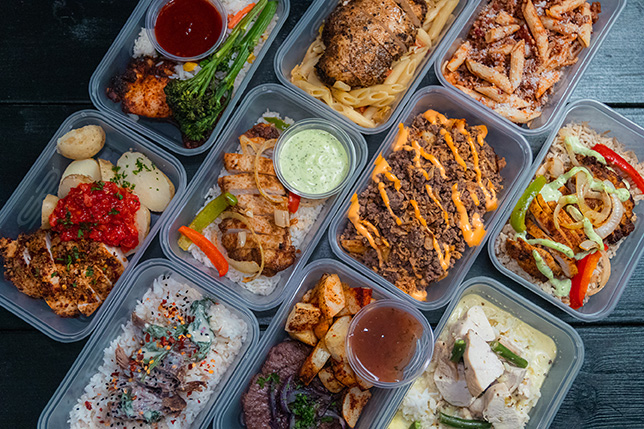Fall 2025
Fueling muscle building with protein to enhance tactical performance

Protein is one of the most talked-about topics in the tactical and fitness community, and for good reason.
It is one of the three essential macronutrients, along with carbohydrates and fat. Protein is vital for maintaining fluid balance, regulating acid-base balance, producing antibodies, controlling hormone levels, supporting immune function, and promoting blood clotting, making protein one of the most versatile nutrients in nutrition. However, most know protein for its contribution to maintaining and growing muscle. Muscle hypertrophy, the scientific term for muscle growth, refers to an increase in muscle size. Resistance training is essential for muscle hypertrophy, and protein intake plays a crucial role in the muscle growth process (Kuśmierska & Kuśmierski, 2024).
Protein plays a significant role in the diet of the tactical athlete due to its ability to help them grow and develop muscle. Military service members and first responders must maintain a certain level of skeletal muscle mass to perform occupation-specific tasks. Leading tactical athletes to wonder what the best way forward is.
Protein is made up of amino acids. If protein were a house, amino acids would be the bricks that make up its structure. There are nine essential amino acids. When all nine essential amino acids are present in a food item, it is considered a complete protein; otherwise, it is considered incomplete if even one is missing. Animal proteins such as beef, chicken, turkey, and fish are complete proteins. Whereas plant-based proteins, such as soybeans, kidney beans, and other legumes, are incomplete proteins because they lack one or more essential amino acids, except soy (Ashtary, 2025).
Unfortunately, plant-based proteins have been shown to negatively impact protein digestibility, amino acid bioavailability, and overall protein quality (Ashtary, 2025). Some research has found that athletes participating in a muscle hypertrophy training program can achieve similar results on either an animal- or plant-based protein diet (Kuśmierska & Kuśmierski, 2024), although this topic remains under investigation. Those who exclusively eat plant-based diets may need to consume two to four times the amount of a single plant protein to catch up with omnivores (Ashtary, 2025). To date, animal proteins remain the more effective source of protein for the tactical athlete; however, vegetarians and vegans should keep soy and a diverse array of plant-based proteins (e.g., chickpeas, mung beans) as staples in their diet.
Should protein be eaten with carbohydrates, or can they be consumed alone? Initially, it was thought that the presence of insulin, which is released when carbohydrates are ingested, helps stimulate muscle protein synthesis; however, that is not actually the case. It is now understood that insulin helps to stop muscle protein breakdown. While this is helpful, it is not the same thing as aiding muscle hypertrophy. Regardless, after training, tactical athletes are still advised to consume carbohydrates with their protein to replenish glycogen stores, as the secretion of insulin will help ensure that no muscle loss occurs (Deldicque, 2020).
Finding the optimal protein intake is an area of ongoing research. Most researchers agree that a high-protein diet is crucial for muscle hypertrophy. High-protein diets are typically defined as those with protein intake exceeding 25% of total calories consumed (Kuśmierska & Kuśmierski, 2024). For example, that would be more than 188g of protein in a 3,000-calorie diet. The International Society of Sports Nutrition recommends 1.4-2.0g/kg per day for exercising individuals (Gonzalez et al., 2022), applicable to both military personnel and first responders.
In the Army, protein intake recommendations for military personnel are suggested to be between 0.8 and 1.6 g/kg/day for both males and females, and should be increased during periods of intense physical exertion and increased metabolic demand (Gonzalez et al., 2022). However, other research suggests that 1.6g/kg is just the starting point for those seeking larger muscles. Kuśmierska & Kuśmierski (2024) suggest that consuming 1.6g/kg per day is beneficial for optimizing increases in lean mass, resulting in enhanced muscular strength, performance, and aerobic capacity. Keep in mind, this is also dependent on the training the athlete is engaged in.

Moreover, due to occupational demands (e.g., field training) or lifestyle changes (i.e., attempting to lose weight), tactical athletes may have reduced caloric intake. In times of total calorie restriction, researchers recommend maintaining some form of resistance training and increasing daily protein intake up to 3g/kg per day if possible (Deldicque, 2020). As research continues to emerge, muscle hypertrophy typically begins at 1.6g/kg and should be tailored to the tactical athlete’s training program until the optimal dosage is determined.
» ALSO SEE: Training the tactical athlete’s energy systems
Protein is considered a vital component of a tactical athlete’s balanced diet and holds significant promise for sustaining health, promoting muscle growth, and ensuring mission readiness.



